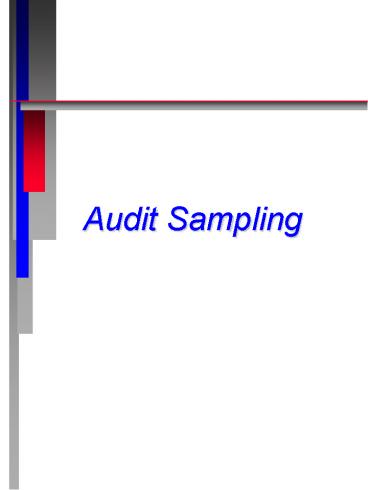Audit Sampling - PowerPoint PPT Presentation
Title:
Audit Sampling
Description:
... purpose of evaluating some characteristic of the balance or ... 3. Identify characteristic of interest. 4. Determine sample size. 5. Selection of sample ... – PowerPoint PPT presentation
Number of Views:31
Avg rating:3.0/5.0
Title: Audit Sampling
1
- Audit Sampling
2
Definition Audit Sampling
- Audit sampling is the application of an
audit procedure to less than 100 percent of the
items within an account balance or class of
transactions for the purpose of evaluating some
characteristic of the balance or class.
3
Audit Risk (Error)
- Sampling Risk (Error)
- Type 1 Error (alpha risk
- risk of underreliance)
- Type 2 Error (beta risk
- risk of overreliance)
- Nonsampling Risk (Error)
4
Audit Sampling Basic Steps
- 1. Define objectives
- 2. Specify population
- 3. Identify characteristic of interest
- 4. Determine sample size
- 5. Selection of sample
- 6. Evaluation of sample results
- 7. Make audit decision
5
Types of Audit Sampling
- Statistical sampling
- Nonstatistical (Judgmental) Sampling
6
Distinguishing Features of Statistical Sampling
- Random or Systematic
- selection
- Mathematical evaluation
7
Representative Selection Methods
- For Statistical or Nonstatistical Sampling
- Random
- Regular
- Probability Proportional to Size
- Systematic
- Regular
- Probability Proportional to Size
- Stratified Random
- For Nonstatistical Only
- Haphazard
8
Unacceptable Selection Methods
- Block selection
- Judgmental selection
- (OK when not sampling)
9
Types of Sampling Plans
- Attribute Sampling
- (eg. Evaluation of Internal Control System)
- Variable Sampling
- (eg. Estimate Account Balances)
10
Determination of Sample Size
R
MDR
n
R
n
TR
11
Determination of Sample Size
- Factors affecting sample size (Independent
variables) - Population
- Confidence Level
- Tolerable Rate
- Precision Range
.
.
2
(
)
N SD Z
n
PR
12
Risk Factor Table
13
Determination of Sample SizeReliability 90
14
Determination of Sample SizeReliability 95
15
Sample Size Estimation Tests of Balances
(Variable Sampling)
BV x R
n _____________
TM
16
Sample Evaluation Tests of Balances (Variable
Sampling)
- Quantitative
- Qualitative
17
Sample Evaluation Method Decision Tree
Ratio
yes
PPS?
yes
no
Difference or Ratio
Perpetual Records?
no
Mean Value
18
Sample Evaluation Tests of Balances (Variable
Sampling)
Mean Value Estimation Method EV M x
N Difference Estimation Method EV TBV /-
ED ED m(d) x N Ratio Estimation Method EV
TBV x (SAVSBV)
19
Sample Evaluation Tests of Balances (Variable
Sampling)
Achieved Precision Range
APR N x SE x Z
If APR gt Materiality Not enough statistical
evidence to accept or reject population Increas
e sample size or have client fix the
population If APR lt ½ Materiality Decision
interval EV /- APR If ½ Materiality lt APR lt
Materiality Calculate Adjusted Achieved
Precision Range AAPR Materiality -
APR Decision Interval EV /- AAPR































